Acoma Pueblo Visitor Center
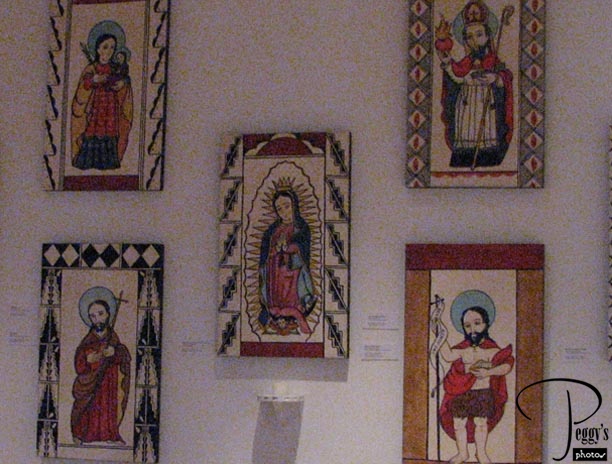
Close–up of the retablos.

Acoma Pueblo Visitor Center
To the Acoma Pueblo
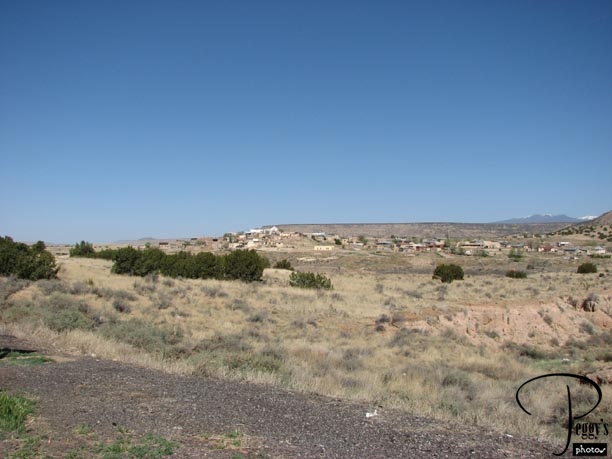
The Laguna Pueblo on a hill. I took this photo from a viewpoint on the highway. There are 19 Indian Pueblo tribes in New Mexico––tribes who live in villages (pueblos). There are a number of pueblos that allow visitors, though some are no more than a hotel and a casino.

To the Acoma Pueblo
To the Acoma Pueblo
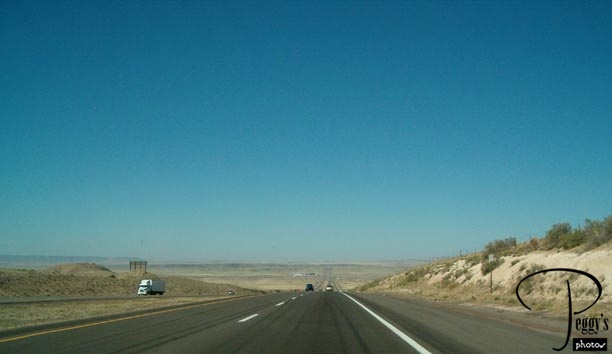
My sister Linda and I started out early this morning to travel to the Acoma (pronounced “Ah–ko–mah”) Indian Pueblo 65 miles from Albuquerque. Linda provided good company, was a good navigator, and took very good photos along the way (I’ll tell you when a photo was taken by Linda). Here we are on the I–40. The weather was sunny, somewhat cool, and very windy. My Volvo did well in the wind and we only had one truck on the route that looked like it was having trouble negotiating the wind. Photo of the desert scenery on the way. (Linda’s photo)

To the Acoma Pueblo
To the Acoma Pueblo
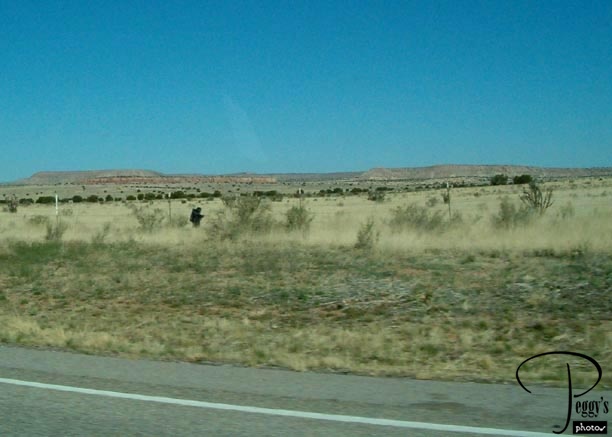
More desert scenery. I very much like the desert and its wide–open spaces. There are many such spaces in New Mexico as much of the state’s land is made up of Indian reservations and most of these have not been developed. (Linda’s photo)

To the Acoma Pueblo
To the Acoma Pueblo
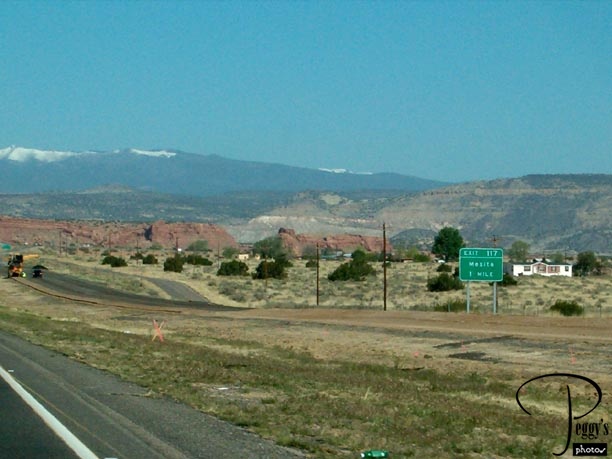
The desert, red sandstone rocks, and snow–capped Mount Taylor. (Linda’s photo)

To the Acoma Pueblo
To the Acoma Pueblo
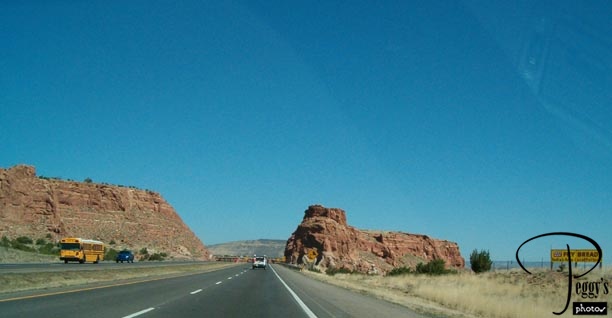
Driving through the sandstone rocks. (Linda’s photo)

To the Acoma Pueblo
To the Acoma Pueblo
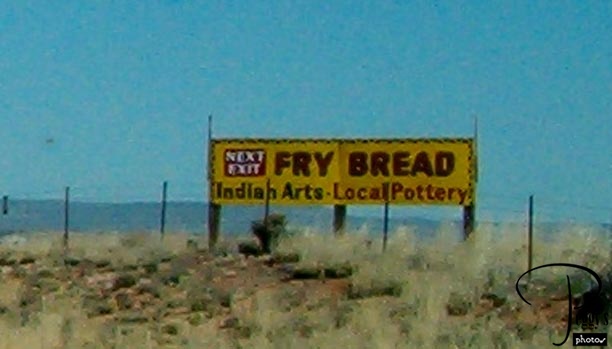
Blow–up of the sign along the road in the last photo. I believe that this turn–off is to the Laguna Pueblo––well worth a visit if you have the time. (Linda’s photo)

To the Acoma Pueblo
To the Acoma Pueblo
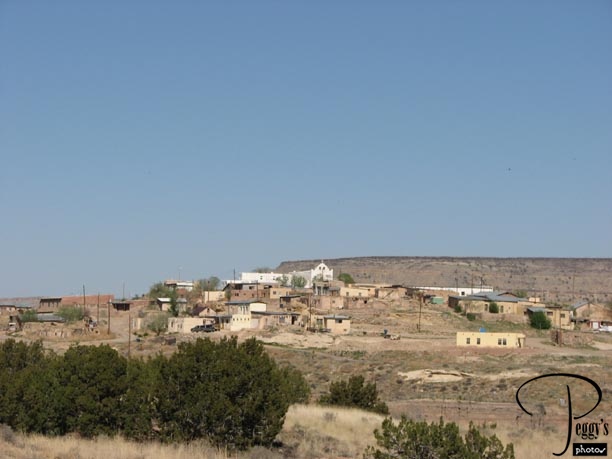
A closer–up view of the Laguna Pueblo showing the San Jose de Laguna Mission Church on top of the hill.

To the Acoma Pueblo
To the Acoma Pueblo
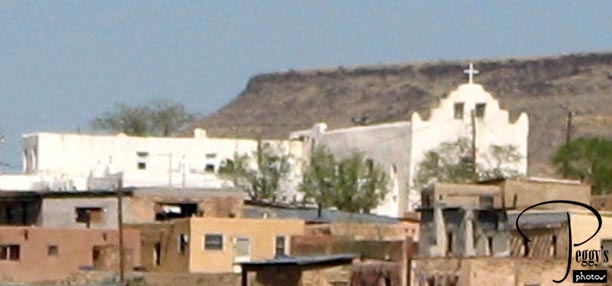
Blow–up of the San Jose de Laguna Mission Church from the last photo.

To the Acoma Pueblo
To the Acoma Pueblo
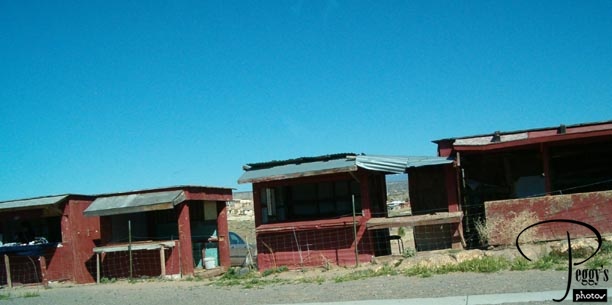
Vendor booth at the viewpoint. Only one booth was occupied and that by a vendor selling jewelry. (Linda’s photo)

To the Acoma Pueblo
To the Acoma Pueblo
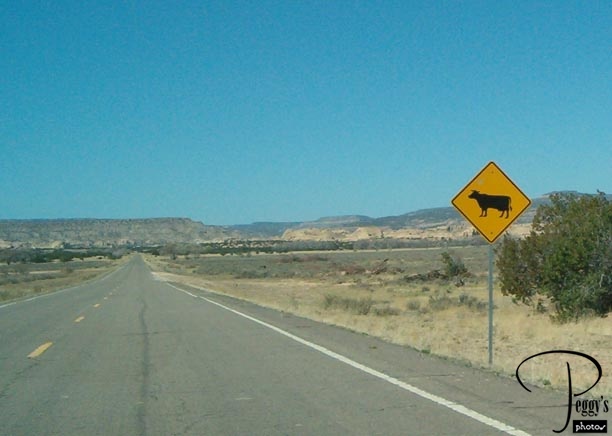
We are now on Highway 23, on the Acoma Indian Reservation. The reservation is of 378,345 acres. On this road, we passed by more cattle than we did cars––only two other cars passed us. We also saw one person on a bicycle. We had to whole desert almost all to ourselves––we enjoyed it. (Linda’s photo)

To the Acoma Pueblo
To the Acoma Pueblo
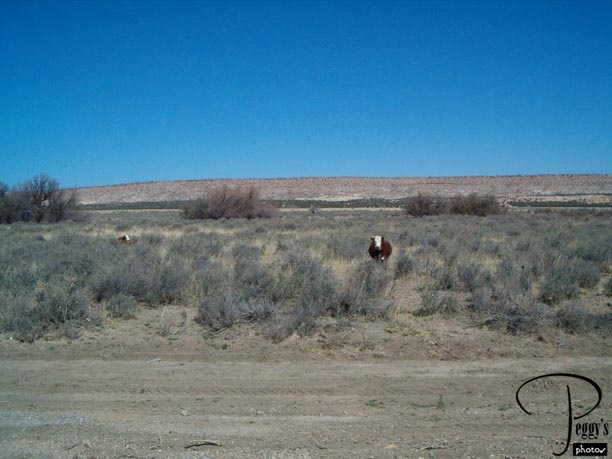
Cattle on the right side of the road. One other cow had just crossed the road to graze on the other side. (Linda’s photo)

To the Acoma Pueblo
To the Acoma Pueblo
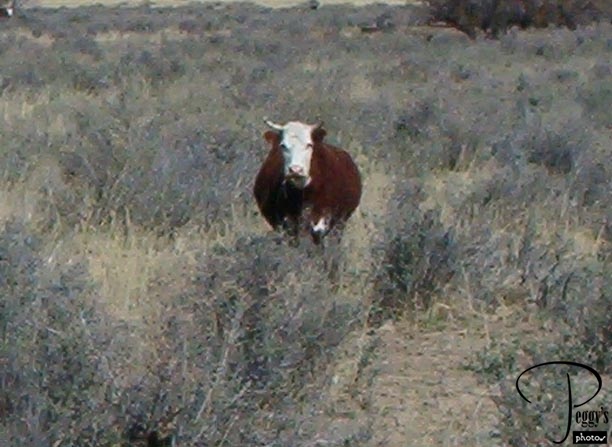
This cow seemed very interested in us. (Linda’s photo)

To the Acoma Pueblo
To the Acoma Pueblo
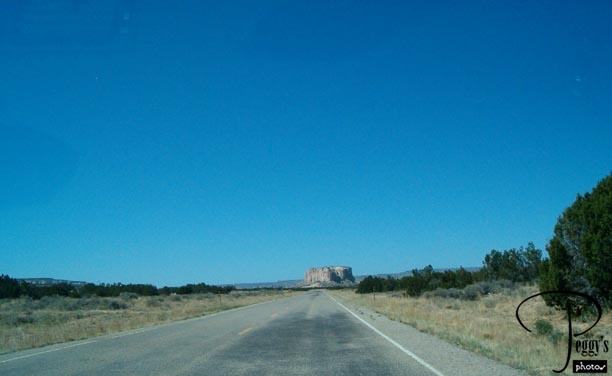
When we saw this mesa, we were hoping it wasn’t the mesa we were going to go up top on to see Acoma’s Sky City––it just looked too high off the ground. (Linda’s photo)

To the Acoma Pueblo
To the Acoma Pueblo
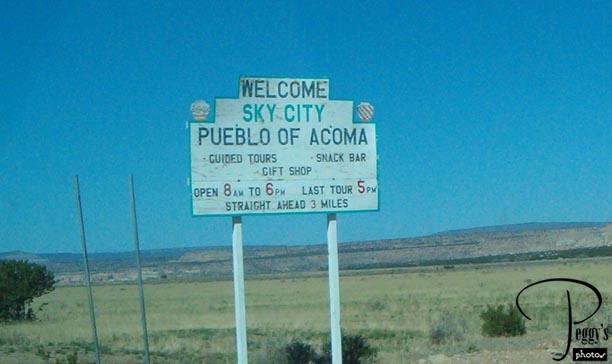
This sign, closer to the mesa, relieved our anxiety. Still three more miles to go. (Linda’s photo)

To the Acoma Pueblo
To the Acoma Pueblo
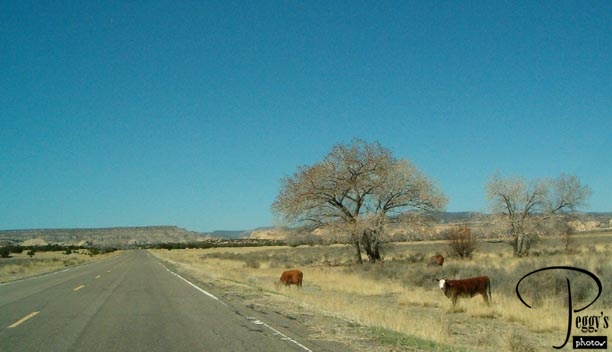
More cows. (Linda’s photo)

To the Acoma Pueblo
The Acoma Pueblo

The first pueblo house that we saw on the reservation. (Linda’s photo)

The Acoma Pueblo
The Acoma Pueblo
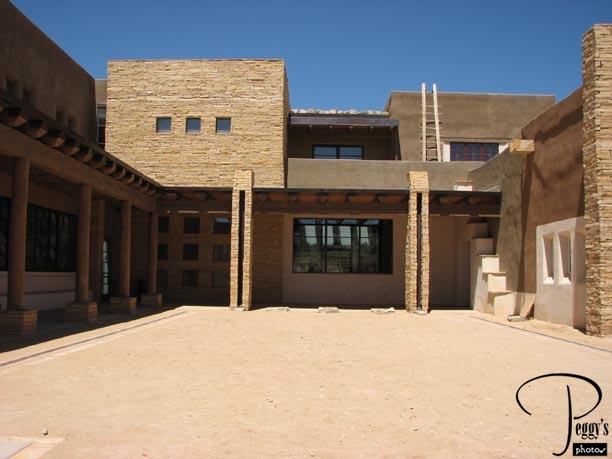
The Acoma Pueblo Visitor Center. We were surprised at the number of cars at the center as we had passed by so few, but they must have taken the longer way to get here where there is a hotel and a casino. We bought the tickets for our tour––about $11, plus a still photo permit for an additional $10. You cannot visit Acoma’s Sky City on your own but must take the tour.

The Acoma Pueblo
The Acoma Pueblo
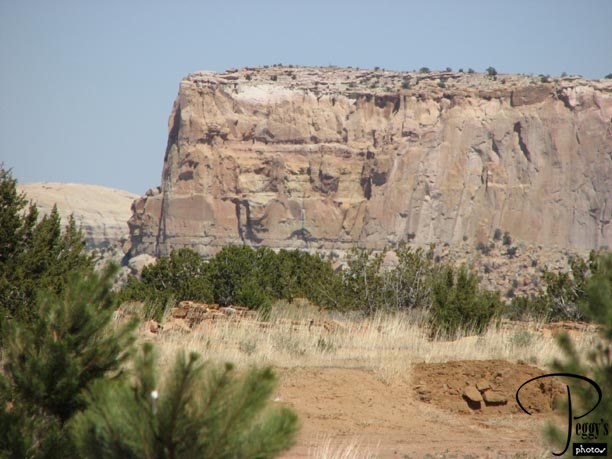
The Rock of Acuco, on which Acoma’s Sky City is located (Acoma means “People of the White Rock”). It is 357 feet high, the height of a 40–story building. The mesa top is about 70 acres. Acoma is the oldest continuously inhabited community in North America (though a few other places make this same claim), dating back to at least 1150 A.D. The first Europeans to visit Acoma was Capt. Hernando de Alvarado and his men during the 1540 Expedition of Coronado.

The Acoma Pueblo
The Acoma Pueblo
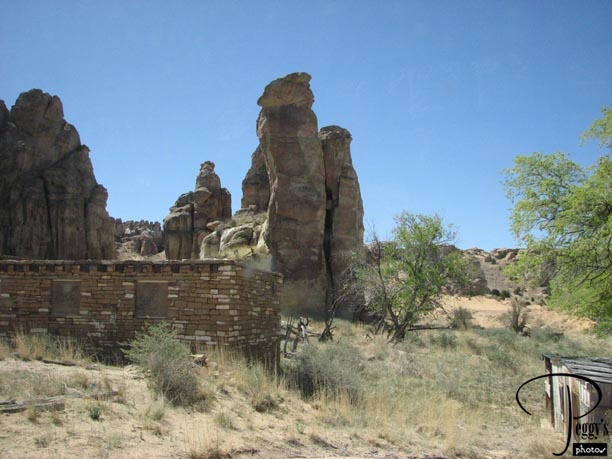
We were driven to the top of the mesa in a small bus over a winding paved road. Photo: Rock pinnacles on the way up to the mesa.

The Acoma Pueblo
The Acoma Pueblo

Another scene on the way up.

The Acoma Pueblo
The Acoma Pueblo
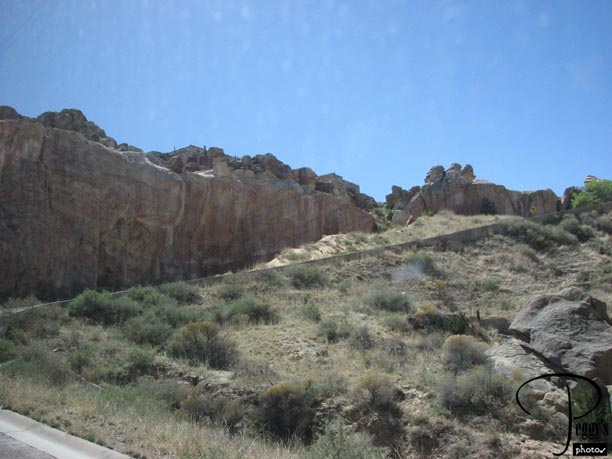
Road up to the top of the mesa. You can make out some buildings on the top.

The Acoma Pueblo
Acoma’s Sky City
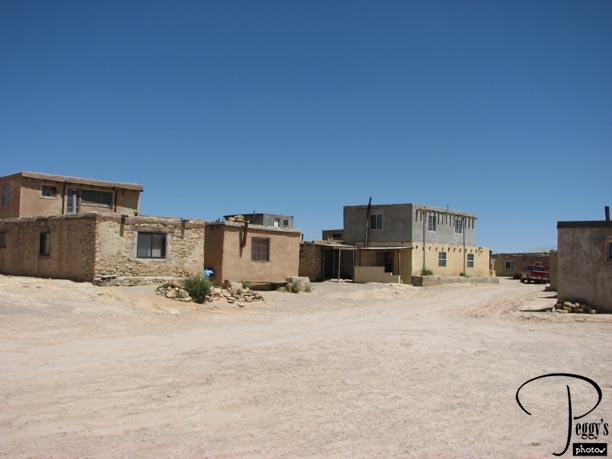
This was our first look at the pueblo buildings on top of the mesa. All the roads were of dirt, which is brought up from the valley below, and the houses are made from adobe bricks. Today, there are about 5,000 Acoma Pueblo Indians, but only 12 familes live permanently on the mesa, but other families come to live on the mesa in the summer or take spiritual retreats here. There is no electricity or running water. Drinking water is brought up and metal or wood outhouses are used. That people are still living at this ancient village made its viewing into a living history and much more meaningful than one of just looking at very old buildings and trying to imagine life here.

Acoma’s Sky City
Acoma’s Sky City
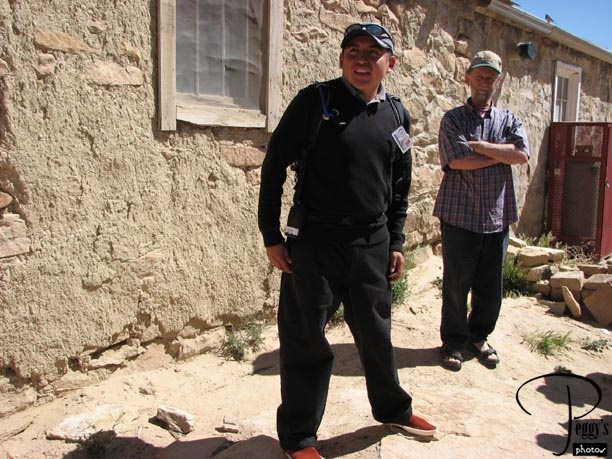
Our tour guide, Alexander (on the left). Many of the Indians have everyday Anglo first names. Alexander is an Acoma Indian and also a student at the University of New Mexico in Albuquerque. The Acoma pay 3/4 of his tuiton in exchange for him guiding tours.

Acoma’s Sky City
Acoma’s Sky City

Walking toward the San Estevan del Rey Mission, built between 1629 and 1641, the building of it overseen by the Franciscan missionary Father Ramirez. The church is dedicated to the martyr San Estevan, who is the patron saint of the mission and also of the Pueblo.

Acoma’s Sky City
Acoma’s Sky City
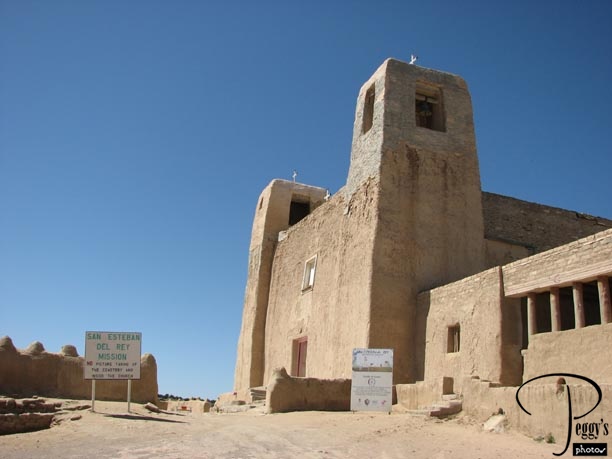
Close–up view of San Estevan del Rey. Its height is 60 feet and its walls are 10 feet thick.

Acoma’s Sky City
Acoma’s Sky City
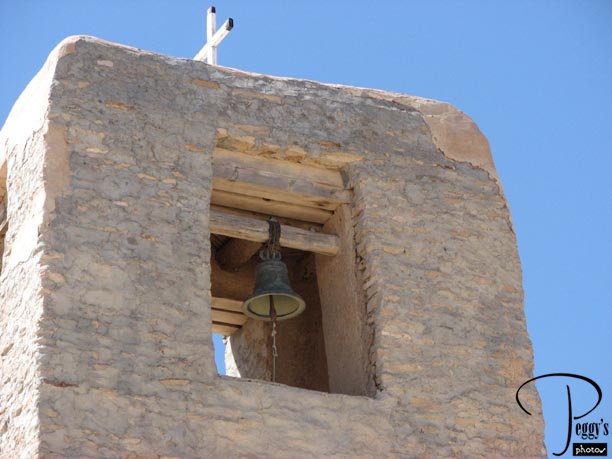
View of its bell tower.

Acoma’s Sky City
Acoma’s Sky City
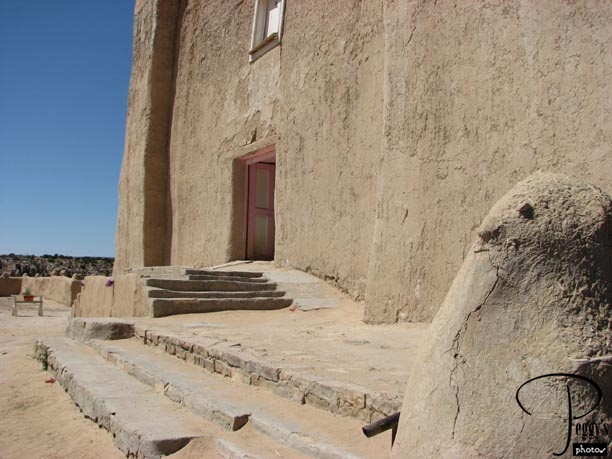
The entrance to the church. There is a 200–square–foot cemetery in front of the church––no photos allowed of it. Burial is in layers, with the dirt brought up from the valley being overlaid as need be. The sculpture on the left is one of the “Soldier Guard” placed around the cemetery during World War I.

Acoma’s Sky City
Acoma’s Sky City
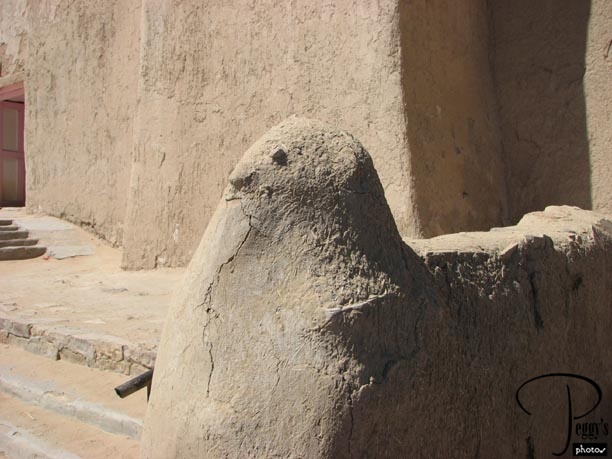
Closer–up view of one of the Soldier Guards.

Acoma’s Sky City
Acoma’s Sky City
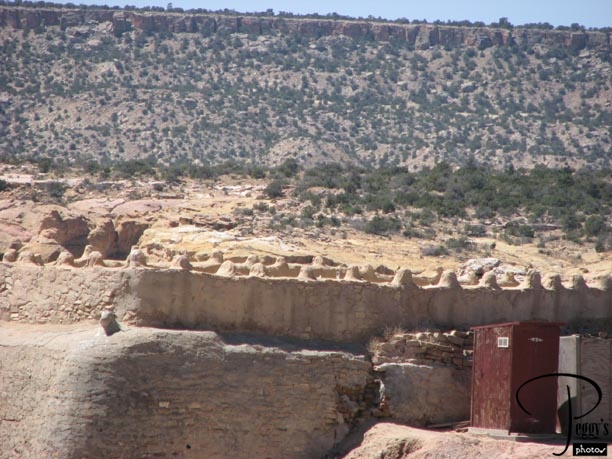
View of the cemetery wall with the Soldier Guards on top of it––photo taken from a distance.

Acoma’s Sky City
Acoma’s Sky City
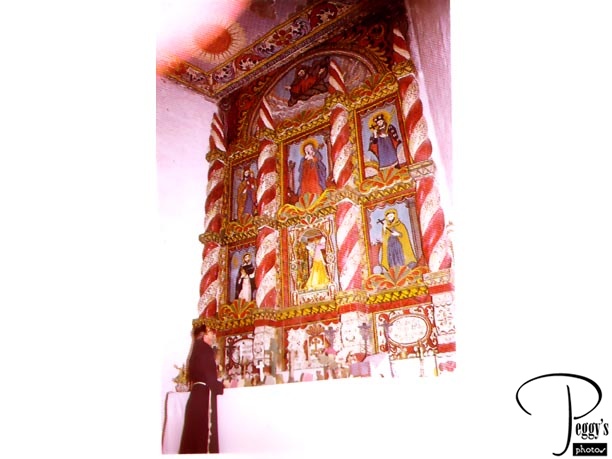
The altar inside San Estevan del Rey. No photos were allowed inside the church, so I scanned this photo of the altar that was in a book on the Acoma Pueblo that I bought at the Visitor Center. I saw this type of altar in other churches in New Mexico. The inside of the church was a long rectangle, similar to the inside of the California Mission churches. There were Indian drawings on the walls and the colors were mainly blue and pink––very pretty. The floor was of dirt.

Acoma’s Sky City
Acoma’s Sky City
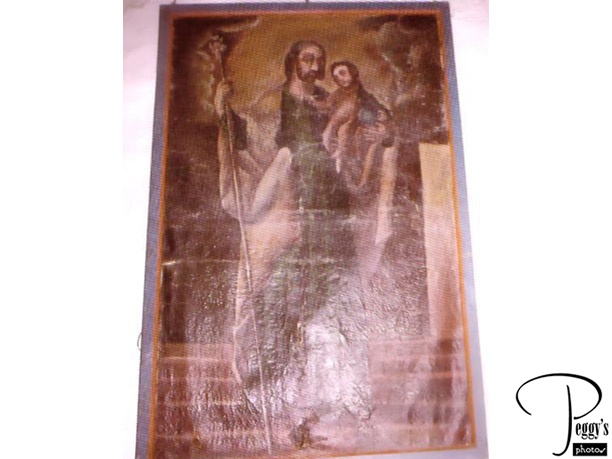
I also scanned this photo from my book on Acoma. It is a miracle painting of San Jose sent to the mission by Charles II of Spain and it hangs in the church. Our guide told us that the Acoma practice a mixture of Catholism and tribal ceremonies. The public is invited to ceremonies at Sky City several times a year.

Acoma’s Sky City
Acoma’s Sky City
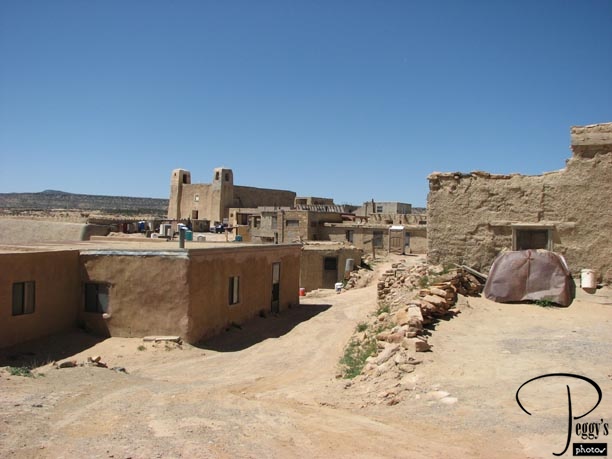
San Estevan del Rey Mission from a distance.

Acoma’s Sky City
Acoma’s Sky City
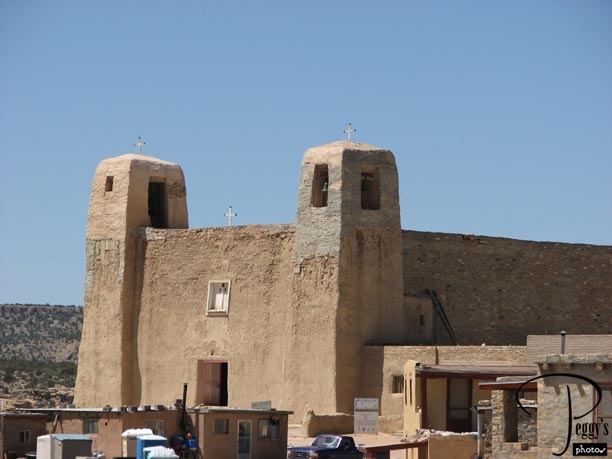
Closer–up view of the mission.

Acoma’s Sky City
Acoma’s Sky City
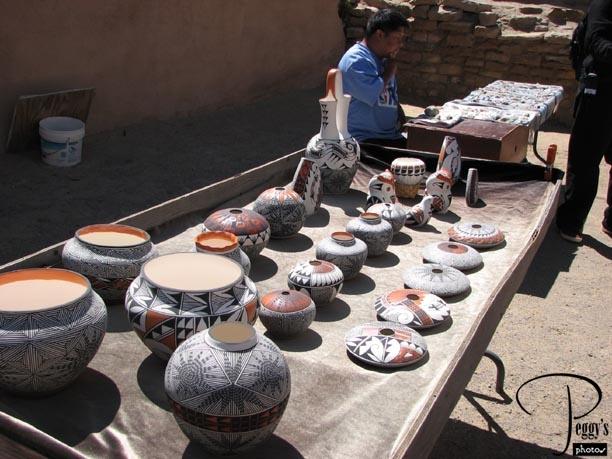
The Acoma are known for their thin–walled white pottery. We were given time on our tour to look at and purchase the pottery. The vendors are the artists themselves or usually someone in their family. The pottery is expensive, but its markup off the mesa is about 100% or more, so if you are going to buy any Acoma pottery, buy it here. Also, there is no sales tax on the reservation.

Acoma’s Sky City
Acoma’s Sky City
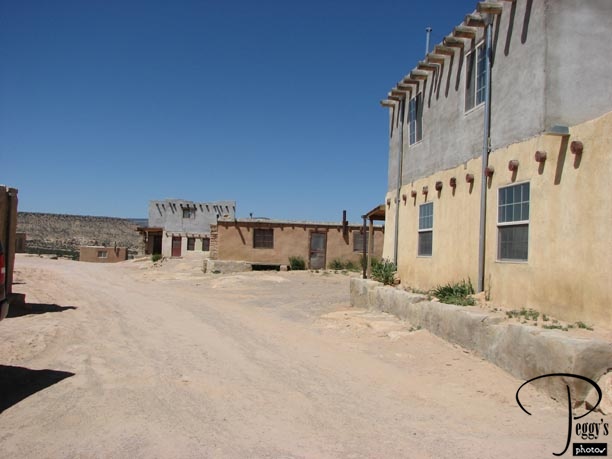
Walking around the Pueblo. Acoma has some very unpleasant history during Spanish Colonial times. In 1598, Don Juan de Zaldivar and 18 of his men came up to the mesa to collect corn that the Indians had promised to give to the Spanish. However, Acoma Chief Zutucapan and his warriors attacked the Spanish party and killed Zaldivar and 12 of his soldiers. As our guide Alexander told us, this was a very bad idea. In 1599, Zaldivar’s brother, Vicente, came back to Acoma with a much larger force to avenge his brother’s death. The Spanish won the three–day battle, killing 600 of the Acomas and then killing, maiming, or putting into servitude the survivors. In 1680, the Acoma joined the Pueblo Revolt against the Spanish, which drove the Spanish out of New Mexico. Twelve years later, the Spanish retuned to New Mexico with a better attitude and, henceforth, the Spanish and the Pueblo Indians lived peacefully together and even joined forces against the raids of the Commanches and the Utes.

Acoma’s Sky City
Acoma’s Sky City
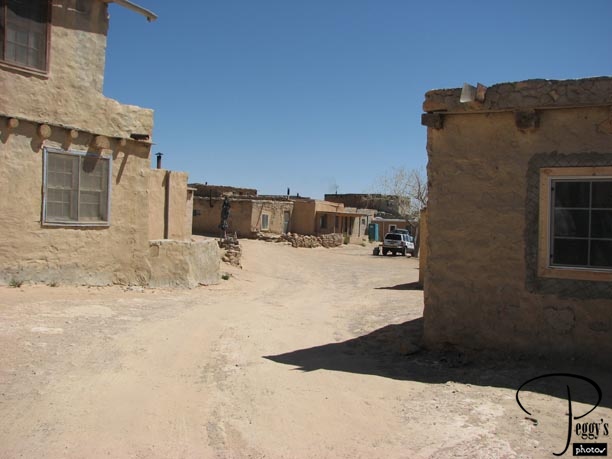
Walking around the Pueblo.

Acoma’s Sky City
Acoma’s Sky City
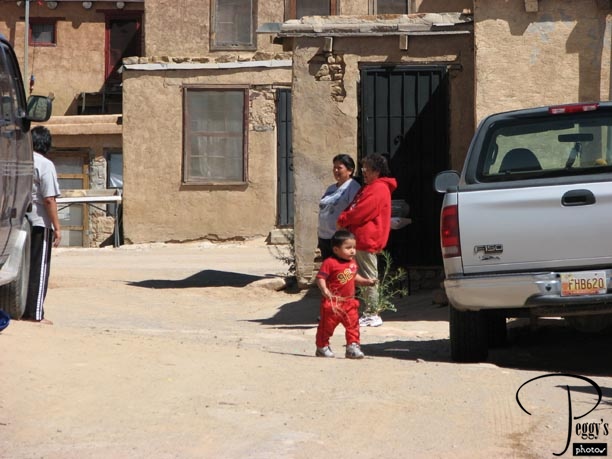
One of the permanent Indian familes living on the mesa.

Acoma’s Sky City
Acoma’s Sky City
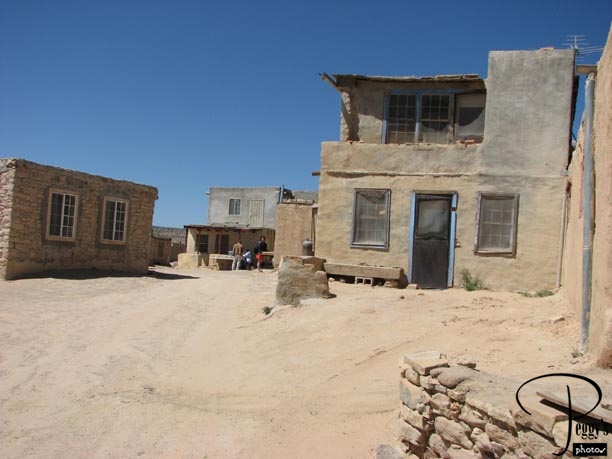
More Pueblo buildings.

Acoma’s Sky City
Acoma’s Sky City
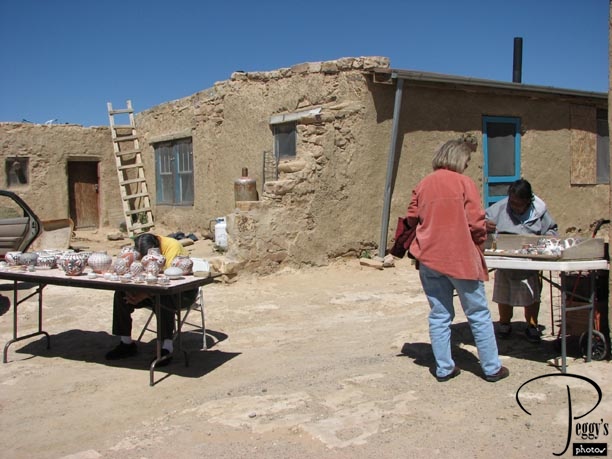
Another Pueblo building and two more vendors.

Acoma’s Sky City
Acoma’s Sky City
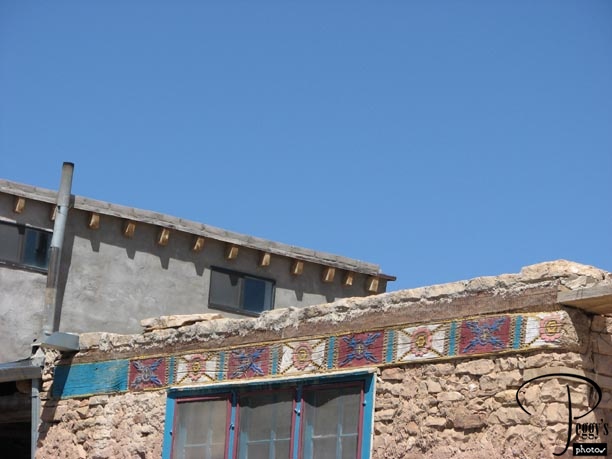
Decorated Pueblo building.

Acoma’s Sky City
Acoma’s Sky City
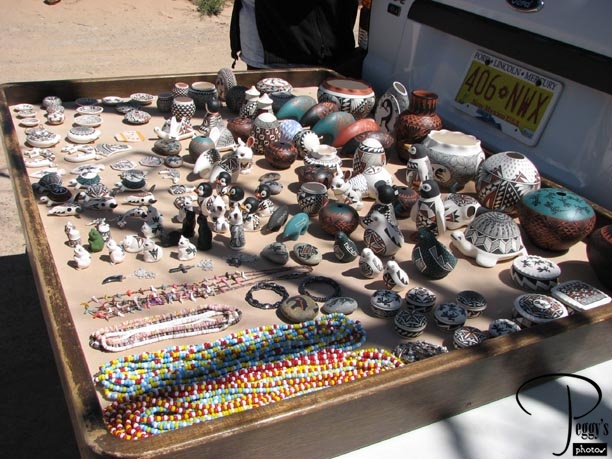
Acoma pottery and beads.

Acoma’s Sky City
Acoma’s Sky City
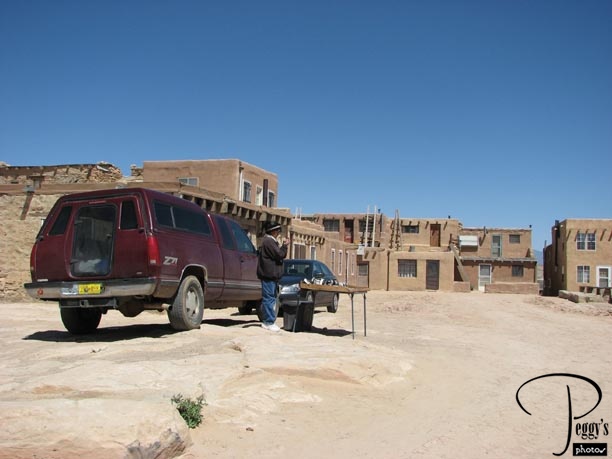
More Pueblo buildings.

Acoma’s Sky City
Acoma’s Sky City
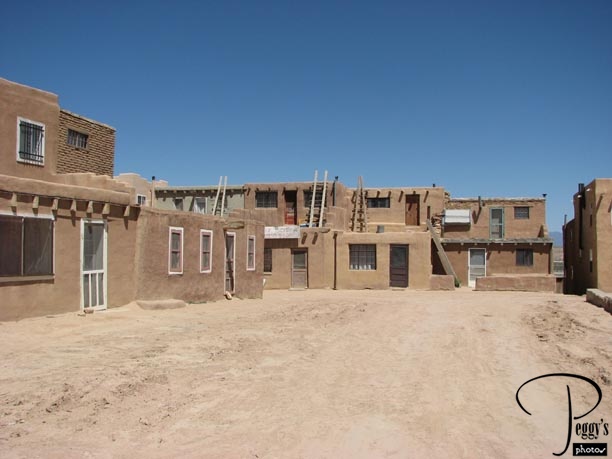
The Plaza where ceremonial dances are held.

Acoma’s Sky City
Acoma’s Sky City
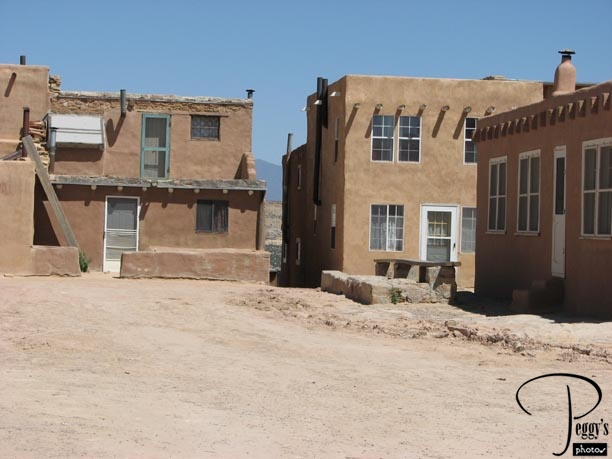
Closer–up view of the Plaza area. On the right are stone steps and a bench where the tribe’s dignitaries sit during the ceremonies. Each Pueblo tribe in New Mexico is a soveign nation, with a governor. On a wall in the office of the Governor of Acoma hangs a Lincoln cane given to him by President Abraham Lincoln. Lincoln gave each of the 19 New Mexican Pueblos one of these canes as a sign that he recognized the tribal authority and as a reward for their neutrality during the Civil War. The cane of the Acoma Pueblo is inscribed: “A. Lincoln, Prst., U.S.A., Acoma 1863. We didn’t get to see the cane, but I was thrilled to realize that one of the canes was here in Acoma. I had just recently read Tony Hillerman’s “Sacred Cows” in which the story revolved around the Lincoln Canes. I told this to Alexander and he smiled in a way that said he was glad that someone outside the tribes knew the story of the Lincoln Canes.

Acoma’s Sky City
Acoma’s Sky City
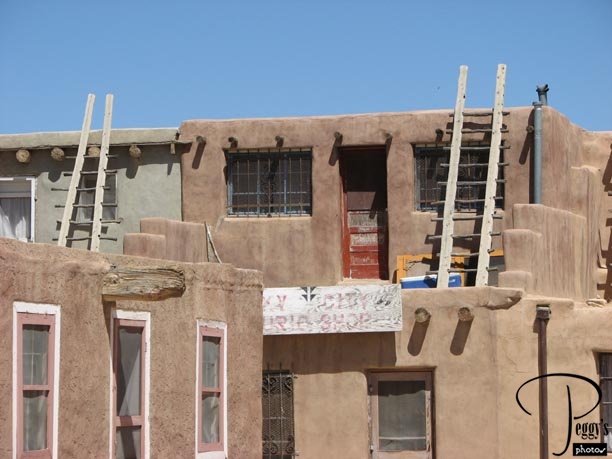
Two–story Pueblo houses. Ladders are used to get to the upper stories and the roof.

Acoma’s Sky City
Acoma’s Sky City
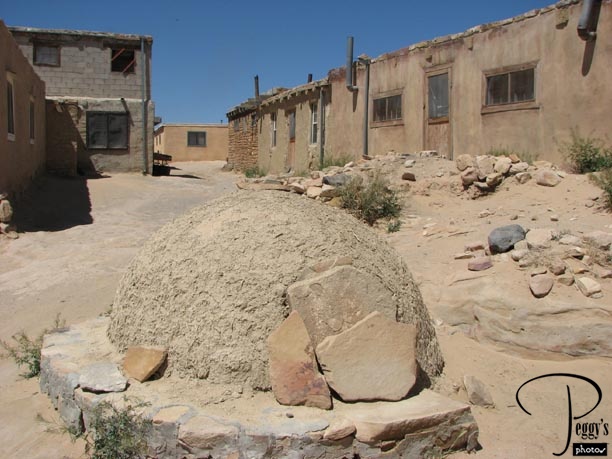
An outdoor oven, no longer in use.

Acoma’s Sky City
Acoma’s Sky City
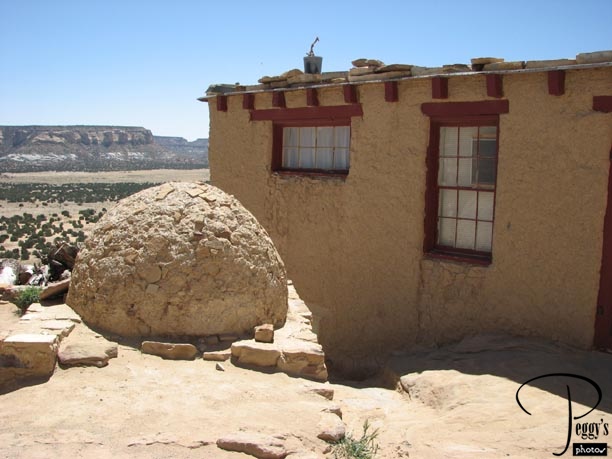
Another outdoor oven with a view of the valley below.

Acoma’s Sky City
Acoma’s Sky City
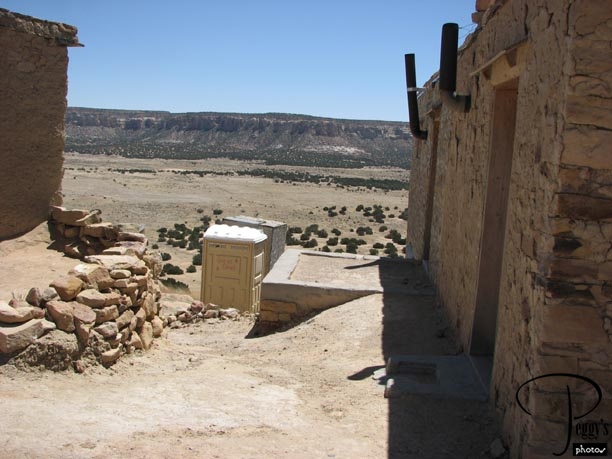
Another view of the valley along with some outhouses. Alexander told us that the outhouses were not for the tour group’s use.

Acoma’s Sky City
Acoma’s Sky City
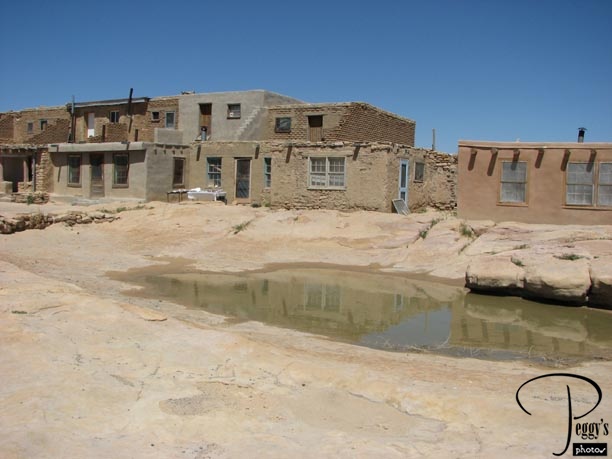
Rain water collection, maybe the resevoir that I had read about––not used for drinking water.

Acoma’s Sky City
Acoma’s Sky City
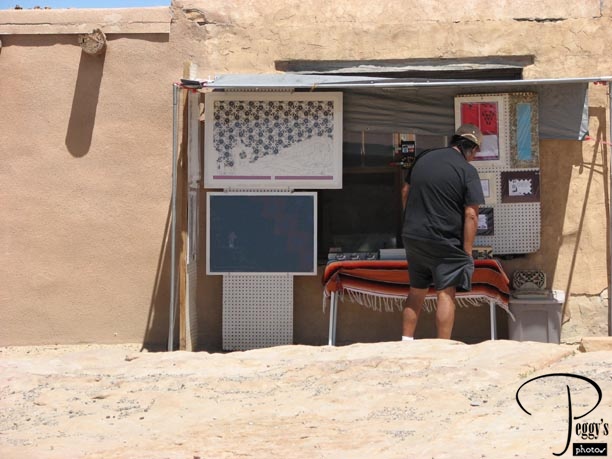
I bought one of this artist’s creations––an Indian–type drawing in a mat frame. I guess this is a good place to mention that all of the Indians that I talked to in New Mexico spoke perfect unaccented English and were very warm and friendly. They made us feel very welcome.

Acoma’s Sky City
Acoma’s Sky City
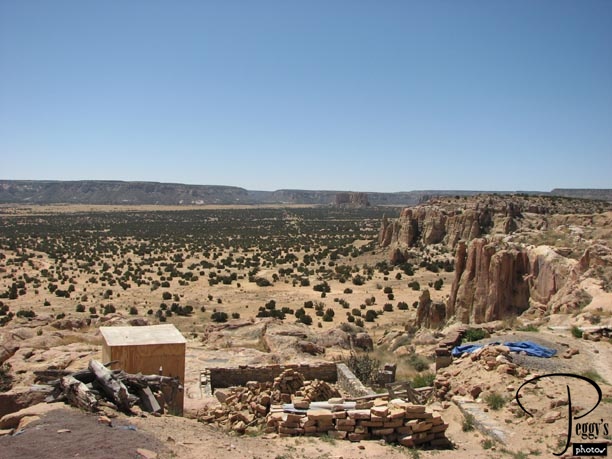
View of the valley from the top of the mesa.

Acoma’s Sky City
Acoma’s Sky City
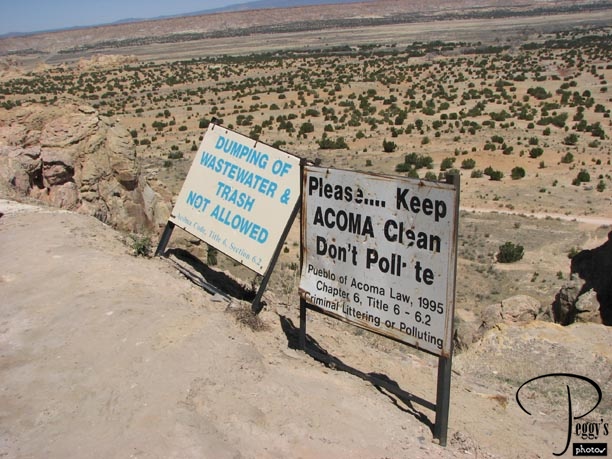
Interesting signs on the edge of the mesa.

Acoma’s Sky City
Acoma’s Sky City
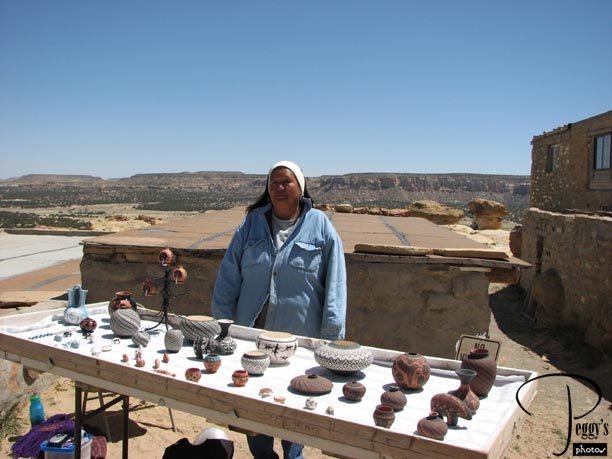
Acoma Indian woman selling pottery.

Acoma’s Sky City
Acoma’s Sky City
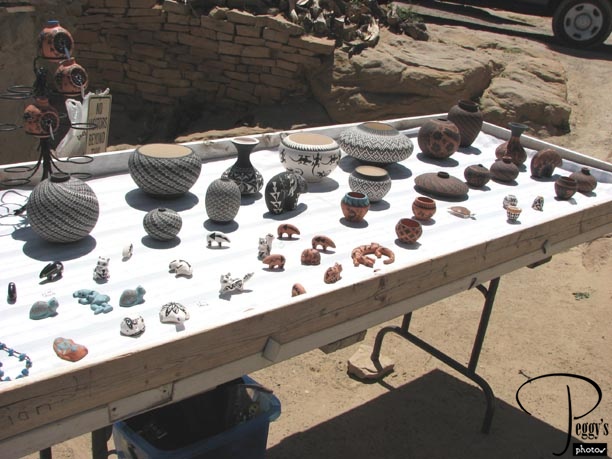
Closer–up view of the pottery.

Acoma’s Sky City
Acoma’s Sky City
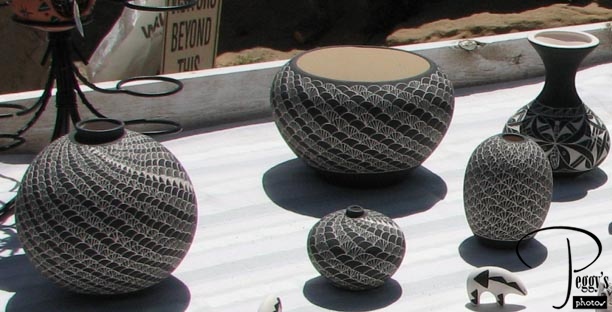
An even closer–up view. By this time, I was in cultural sticker shock at the prices of the pottery that I really wanted to purchase. For vases about the size of the one on the left, the prices ranged from $100 to over $1,000, though a vase with a design like the one in the photo would cost way more than that low price of $100. I bought the little black and white seed vase in the photo––$25, which I think was quite a bargain

Acoma’s Sky City
Acoma’s Sky City
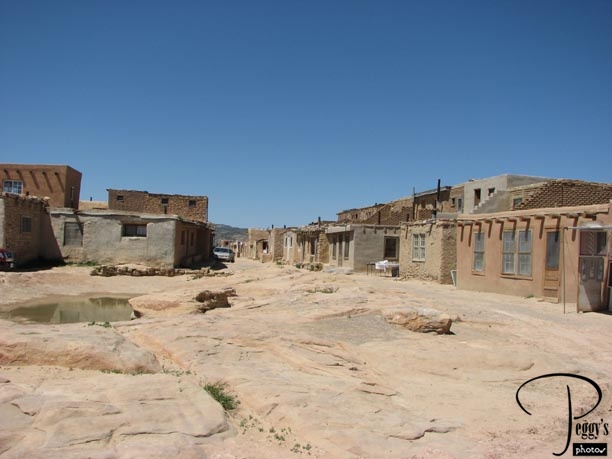
More of the Pueblo.

Acoma’s Sky City
Acoma’s Sky City
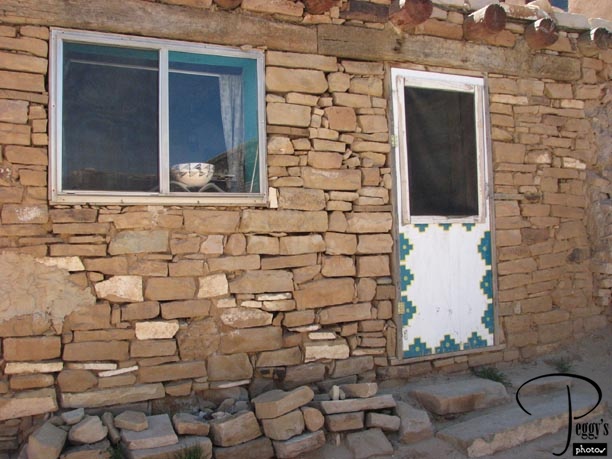
A decorated door. You can also see here the uneven adobe bricks used in the building’s construction. These look like they were formed by hand without the use of molds.

Acoma’s Sky City
Acoma’s Sky City

Our tour group negotiating large rocks at the edge of the mesa (my sister is not in the photo). The rocks became even more difficult to walk over and Linda asked me if this was like walking in ancient sites in Greece––yes, very similar. But I assume that it is always tourist beware when you visit an Indian reservation as I don’t think a personal injury lawyer has the right to sue an Indian soveign nation for your injuries.

Acoma’s Sky City
Acoma’s Sky City
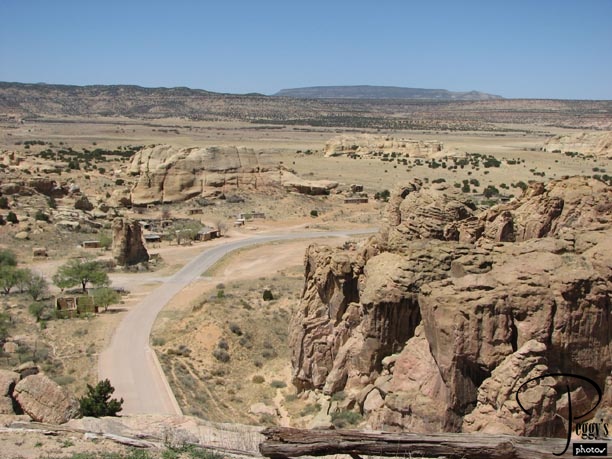
A view from the edge of the mesa.

Acoma’s Sky City
Acoma’s Sky City
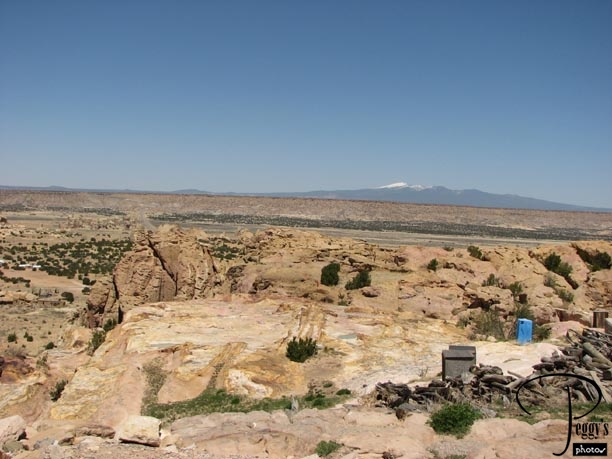
Another view with snow–capped Mount Taylor in the background.

Acoma’s Sky City
Acoma’s Sky City
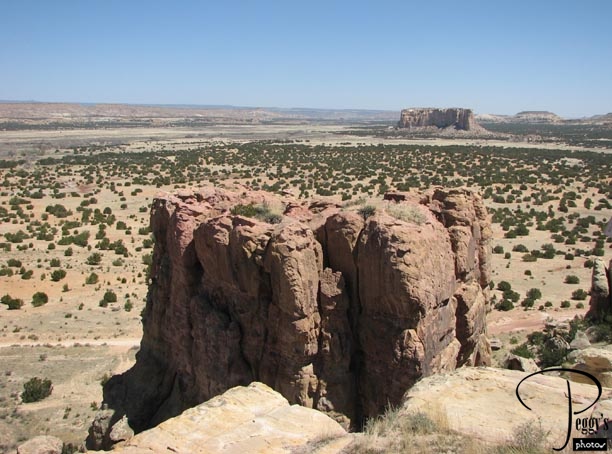
And a last view. A good number of our tour group climbed down from the mesa on a stepped pathway. Linda and I took the bus back down to the Visitor’s Center.

Acoma’s Sky City
Acoma Pueblo Visitor Center
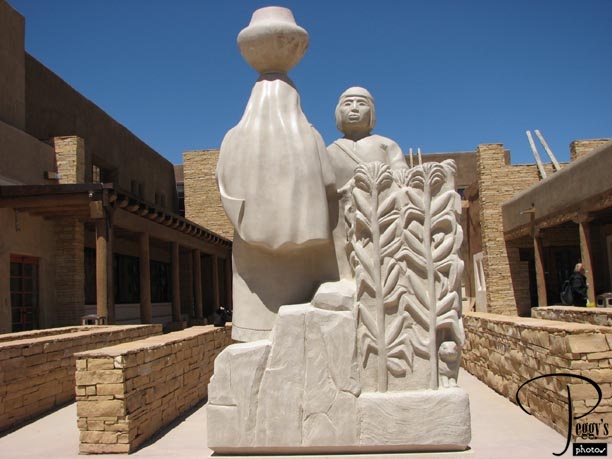
Sculpture in front of the Visitor Center.

Acoma Pueblo Visitor Center
Acoma Pueblo Visitor Center
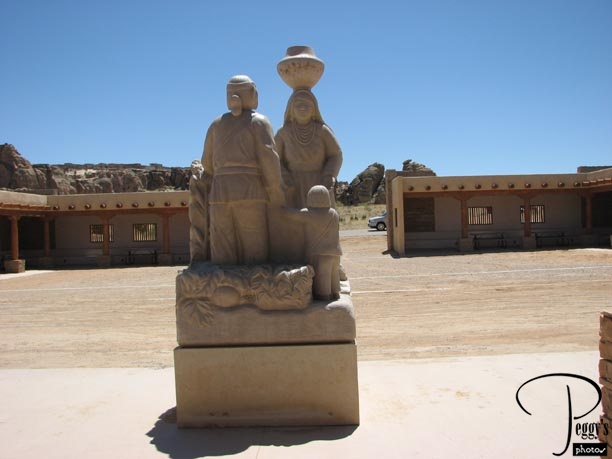
View of the sculpture from the other direction.

Acoma Pueblo Visitor Center
Acoma Pueblo Visitor Center
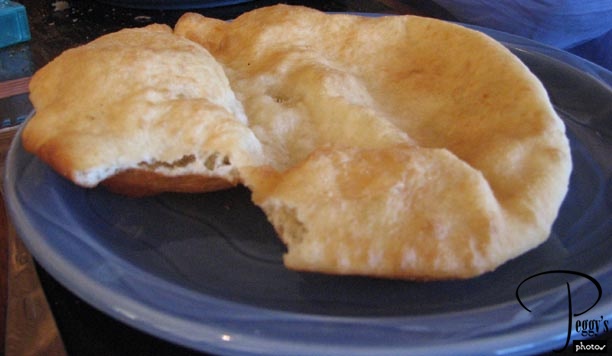
We were hungry. Time for lunch, which we had at the restaurant at the Visitor Center. Linda and I both had sandwiches on Indian oven bread and each a side order of Indian fry bread––shown in the photo. The fry bread was served with honey to use as a sweetner. Indian fry bread is made with flour, warm water, baking powder, and salt and is deep fried. It is quite tasty and makes a great sandwich bread when sliced in half.

Acoma Pueblo Visitor Center
Acoma Pueblo Visitor Center

We didn’t visit the museum at the Visitor Center as we were too tired. But we did walk around the center and saw these decorative Indian tiles.

Acoma Pueblo Visitor Center
Acoma Pueblo Visitor Center
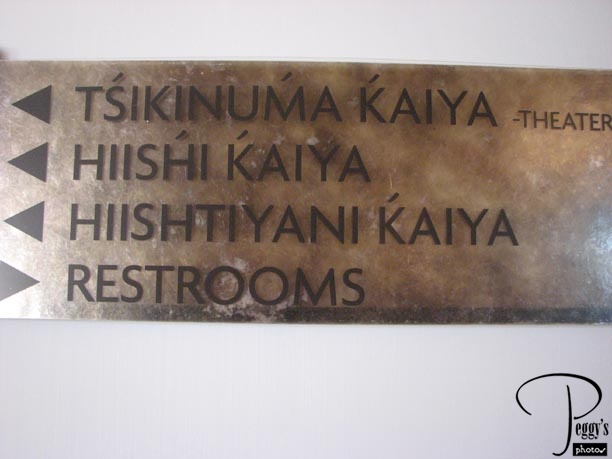
There are three language groups spoken by the Pueblo Indians: Zunis, Keres, and Tanoans. The Acoma Indians speak Keres and I assume that the top three lines in the photo are in Keres.

Acoma Pueblo Visitor Center
Acoma Pueblo Visitor Center
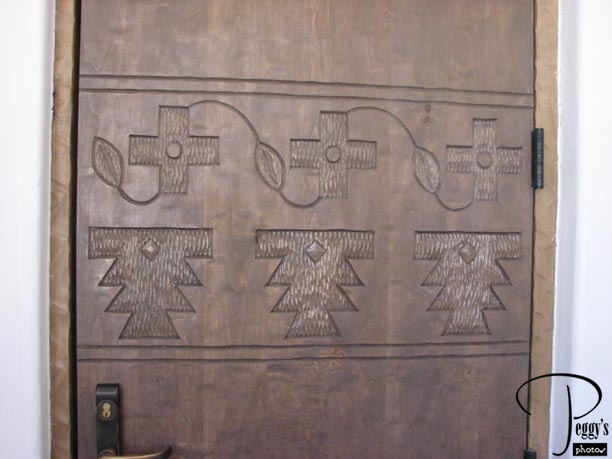
Indian designs on a door.

Acoma Pueblo Visitor Center
Acoma Pueblo Visitor Center
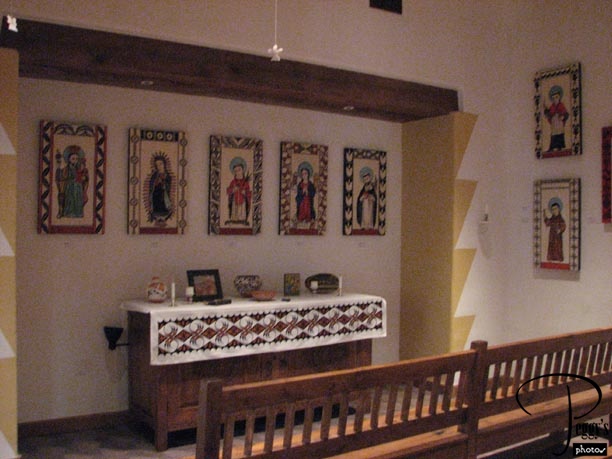
A small chapel at the Visitor Center with many retablos (religious paintings) on the walls.

Acoma Pueblo Visitor Center
Acoma Pueblo Visitor Center
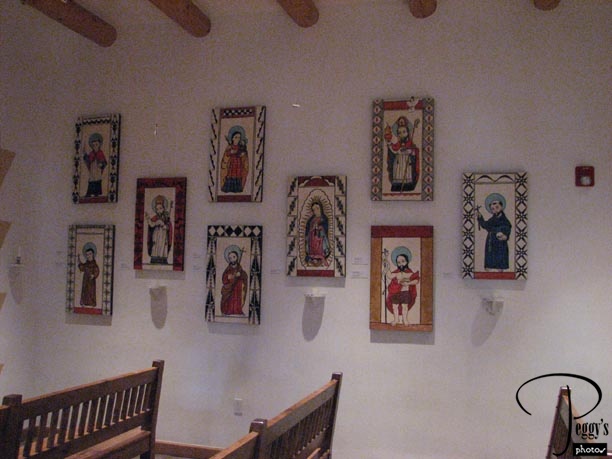
More of the retablos.

Acoma Pueblo Visitor Center
Acoma Pueblo Visitor Center

More of the chapel’s walls.

Acoma Pueblo Visitor Center
Acoma Pueblo Visitor Center

A sculpture at the Visitor Center.

Acoma Pueblo Visitor Center
Acoma Pueblo Visitor Center
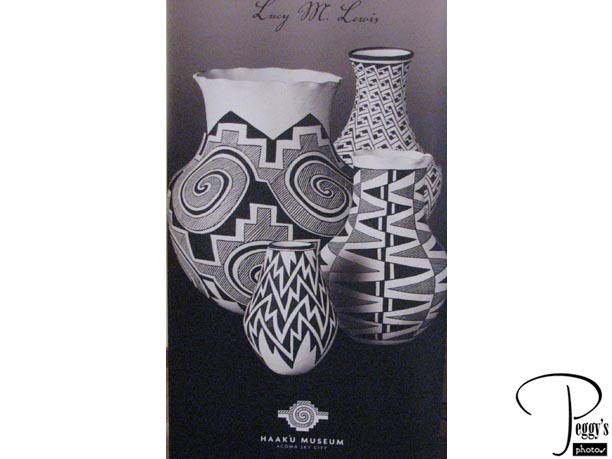
Part of a poster in the lobby showing Acoma pottery.

Acoma Pueblo Visitor Center
Going Back to Albuquerque
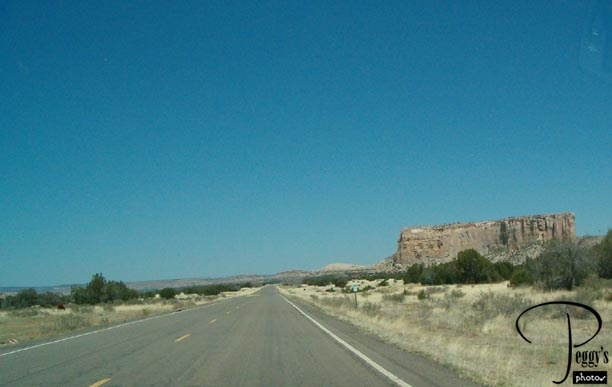
We left the Visitor Center and headed back to Albuquerque. Again, on Highway 23 through the reservation, we encounted very few cars. Looking toward the Enchanted Rock. (Linda’s photo)

Going Back to Albuquerque
Going Back to Albuquerque
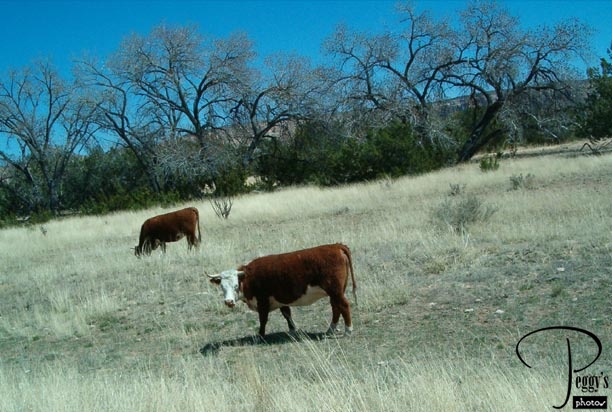
Close–up of the cows. (Linda’s photo)

Going Back to Albuquerque
Going Back to Albuquerque
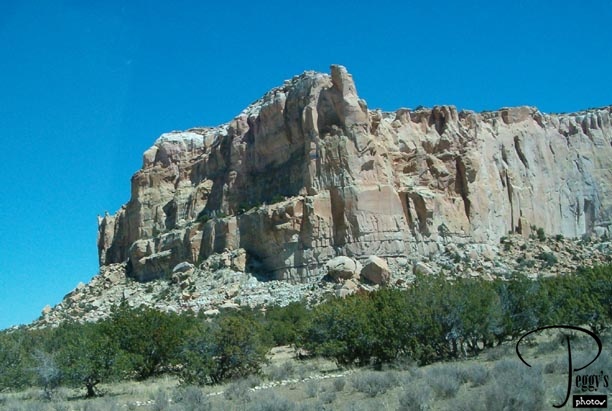
Closer–up view of the Enchanted Rock. (Linda’s photo)

Going Back to Albuquerque
Going Back to Albuquerque
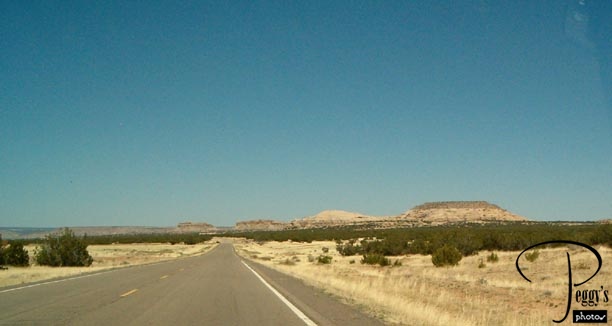
Onward through the desert. (Linda’s photo)

Going Back to Albuquerque
Going Back to Albuquerque
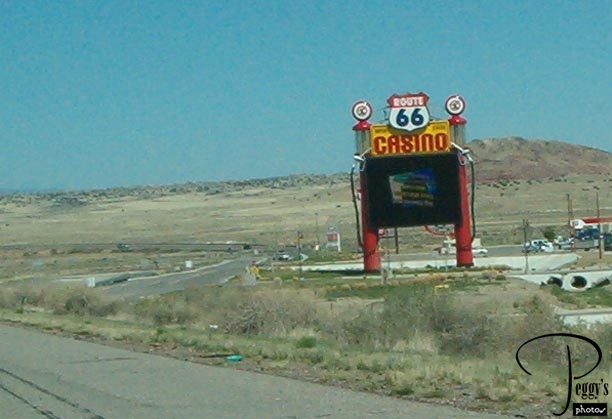
We are now back on I–40 passing the Route 66 Casino. (Linda’s photo)

Going Back to Albuquerque
Going Back to Albuquerque
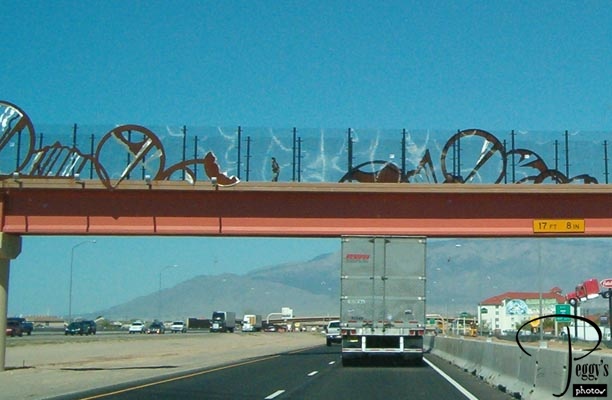
One of the many decorative bridges in Albuquerque with the Sandia Mountains in the background. (Linda’s photo)

Going Back to Albuquerque
Going Back to Albuquerque
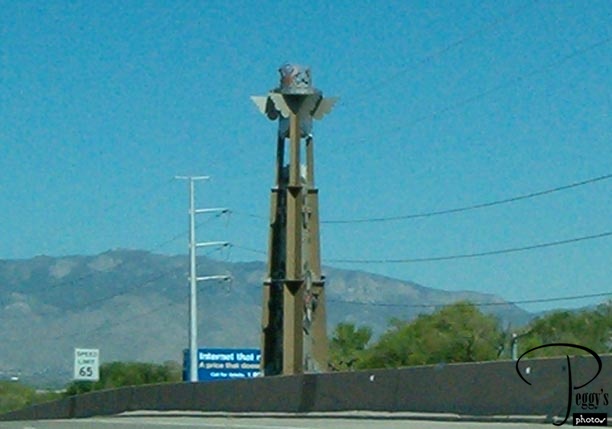
One of the two statues greeting visitors to Albuquerque. (Linda’s photo)

Going Back to Albuquerque
Going Back to Albuquerque
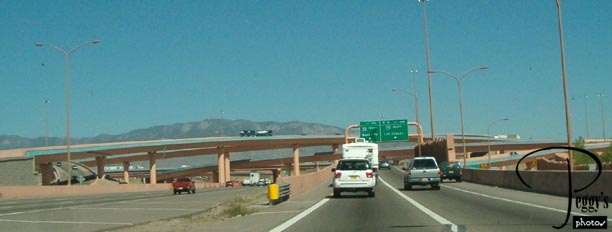
The major interchange in Albuquerque between the I–40 and the I–25. This one is decorated in blue and pink. We were now only about 15 minutes from Linda’s home. Both of us very much enjoyed our adventure to Acoma and we highly recommend it as a definite site to visit. (Linda’s photo)
